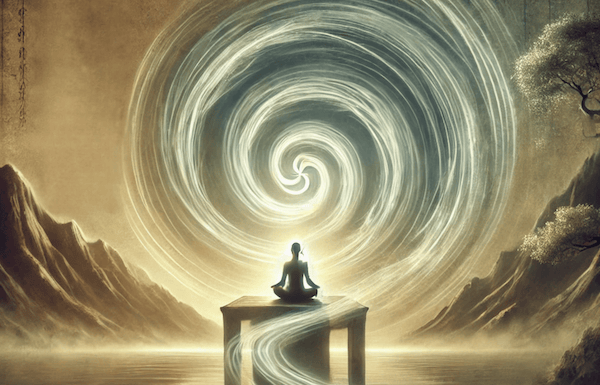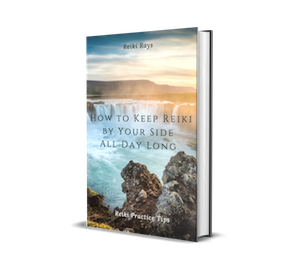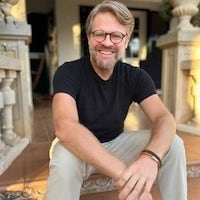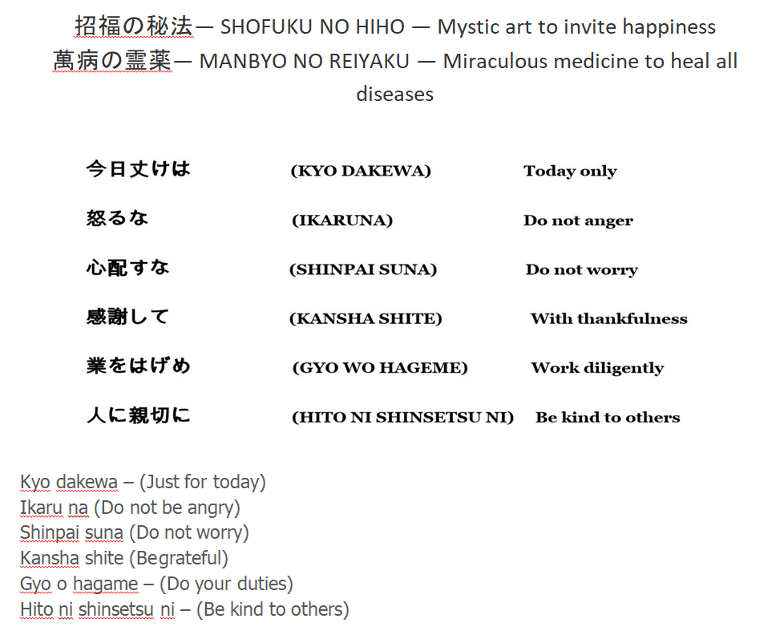“Reiki”, as it is commonly practiced and understood, is often viewed through the lens of healing. It is frequently categorized as an energy healing modality, a tool to balance the chakras, or a practice to raise vibrational frequencies. These may be relegated to modified or newer versions of the practice and are far removed from the origins of Reiki – which is Usui Reiki Ryoho. However, such interpretations, while prevalent, may obscure the true essence of Reiki. If we reverse our conventional understanding and detach from the expectation of healing, we may come closer to grasping the profound depth of this practice. Reiki is not about seeking an outcome but about surrendering to the present moment and cultivating a state of stillness within the mind. Usui Reiki Ryoho is a path toward internal peace and the realization of a mind at ease, everything else that may arise can simply just be allowed to arise and pass.
The Core Practices of Usui Reiki Ryoho
Usui Reiki Ryoho is structured around three fundamental daily practices, which are widely taught and understood. The three cornerstones of the practice are:
- The Recitation of the Precepts (Gokai) – Ideally practiced in the morning and evening, these guiding principles provide a framework for ethical and mindful living. The precepts are a reminder to cultivate gratitude, release anger, and be present in daily life.
- Daily Self-Treatment – This involves meditative hand positions and breathing techniques that help cultivate inner stillness and awareness.
- Reiju (Attunement Process) – Traditionally, Reiju is an initiation process. Still, it can also be understood as a form of self-attunement, a return to one’s natural state of balance and peace.
Integrating these practices should lead to a mind and body that are increasingly more calm, still, and at peace. In such a state, there is no need for healing—because there is no sickness. Illness, both physical and emotional, arises from attachment and disturbance of the mind. When the mind is at ease, the body follows, and suffering dissipates.
The Nature of Reiki as Non-Healing
Shin Shin Kaizen Usui Reiki Ryoho translates to “The continuous improvement method of the mind and then the body first taught by Usui Sensei.” This name itself emphasizes that the practice is fundamentally about cultivating the mind. It does not mention healing in the sense that many practitioners commonly assume. Instead, it suggests a gradual refinement, a daily practice that leads to an ever-deepening inner peace.
Additionally, the goal of the practice is encapsulated in the concept of Anshin Ritsumei—“To put one’s mind at ease and leave one’s body to its natural destiny, and not let one’s mind be moved by other things.” This philosophy suggests that true well-being does not come from manipulating energy or striving for physical healing but rather from a state of surrender and deep trust in the natural flow of life.
The Gokai (precepts) further reinforce this perspective. The precepts invite practitioners to let go of worry, anger, and attachment and instead embrace gratitude, honesty, and kindness. If these principles are truly embodied, healing becomes irrelevant as a goal or expectation. A mind free from suffering does not seek healing—it simply exists in stillness and peace.
The Paradox of Reversing Our Approach
Most approaches to Reiki—whether Western or even specific contemporary Japanese interpretations—are framed transactionally. Reiki is often presented as something to be given, received, or manipulated. Further, new forms of “Reiki” are often proclaimed to be more powerful than others, or upgrades, or direct channelings. Practitioners may approach Reiki with the expectation of achieving specific outcomes, such as clearing energy blockages, healing ailments, or experiencing profound spiritual insights, or one may believe that the form of the practice is “more powerful” or with new and upgraded symbols. This is the nature of a distracted mind, an attached mind, and attachment is the very root of suffering. If we are not able to recognize all aspects of attachment via a mind that constantly seeks validation, then we will remain adrift within these mental distractions. To be clear, we all attach and we must all do our very best to work on the nature of our own mind. We may try to do our best to recognize the practice from two approaches, which you can ask yourself as a set of rhetorical questions:
- Is this aspect of my practice framed within my mind? If so, then this is attachment
- Is this aspect of my practice my best effort towards no mind? If so, then this is moving away from attachment
By reversing our approach, we can see Reiki not as something that does but as something that simply is. What if we simply sat with the practice instead of seeking healing? Instead of trying to do Reiki, what if we allowed ourselves to be Reiki? Might we be able to recognize that the importance of the practice is not while we are “in practice” but rather that the practice is, indeed, our life in total? The precepts are here to guide us in each moment, in each breath, and in each decision. If we are able to incorporate the deep wisdom of the guiding precepts into each moment of our day – to the best of our ability, of course – then we may begin to understand the first titles that precede the precepts:
招福の秘法 – SHOFUKU NO HIHO — Mystic art to invite happiness
万病の霊薬 – MANBYO NO REIYAKU — Miraculous medicine to heal all diseases
These titles to the precepts, to me, are so deep and profound. They help us to recognize our true state of being – or our true nature – is one that is found in true happiness. And from this space of true happiness, we may finally recognize there is a “miraculous medicine” that can “heal all diseases”.
True happiness is found in nothing. It is without form, want, result, outcome, or need. It is no mind, and yet, paradoxically, it is, as well, the universe. It is found in the state of being of anshin ritsumei. It is found only by shedding attachments and dropping the spectacle of the mind. This may seem difficult, however, arriving here or not is not the point. Rather, the focus of the practice should be to try your best to work towards anshin ritsumei and to recognize that everything else is simply suffering. If we arrive at anshin ritusmei or not, this is not the focus, but rather the direction that we should strive to aim towards. Perhaps return to the two rhetorical questions from before and ask those of yourself as often as needed. You, I, and everyone else are all human – so we need to constantly work on this. This is no more or less true for anyone, regardless of their perceived depth of practice. I need to try my very best, constantly, to work towards a still mind and I also need to recognize that if I make such stillness the focus, then I am once again lost in the nature of my busy mind. It all may sound confusing, but perhaps it is easier to recognize then it may seem.
The Simplicity of True Practice
My teacher, Inamoto Sensei, encapsulates the essence of Reiki beautifully with the simple phrase:
Place your hands, surrender, and smile.
This phrase strips away all mystical and transactional elements from the practice and brings it back to its purest form: presence. When we place our hands within the practice—whether on ourselves or others—we are not channeling energy, balancing chakras, or invoking spiritual beings. We are simply being present, allowing ourselves to settle into a state of stillness.
The true transformation occurs not in what Reiki “does” but in what it allows. It provides a space where we can let go of all expectations, relinquish the need for results, and simply be in a state of openness. This is where the deepest healing—if we must use the word—takes place, not because we are seeking it, but because we have surrendered all need for it.

Striving Toward a Neutral Mind
A truly neutral mind is free from the dualities of seeking and avoiding, attachment and aversion, expectation and disappointment. In Usui Reiki Ryoho, we strive toward this state—not as an endpoint but as a continuous practice. The point is not whether one reaches this state immediately or at all. The point is that stillness should always be how we move.
In a world where healing modalities are often marketed as solutions to external problems, Usui Reiki Ryoho offers a radical alternative: there is nothing to fix. There is only the mind to still. When the mind is still, healing is irrelevant because suffering ceases to exist.
Where does this leave the practice?
Usui Reiki Ryoho is not about healing in the conventional sense. It is a practice of internal refinement, cultivating profound stillness and surrender. By reversing our shared understanding of Reiki—from something we do to something we simply are—we can move beyond attachment and experience the true essence of this practice. Perhaps, during your next self-practice or time within a Reiki share or with a client, just let go and reverse your approach to your practice. Perhaps just bow in Gassho and remain here until you find mental stillness, and then from there, just be. Just be with your client, or be with yourself. There is no need to seek mystical outcomes or transactional exchanges. Instead, we simply place our hands, surrender, and smile. In doing so, we align with the natural flow of life, experiencing profound peace and contentment without needing anything beyond this moment. Your mind will wander, your attachments will arise again, your internal distractions will tempt you, your visions will distract you, and your “claires” will try to persuade you – this is normal, and eventually, it is inevitable. The importance here is to return to stillness as soon as you can and try your best to not become attached by the distractions. All of these “experiences” are simply states and projections of your own mind, nothing else, and if we are striving to:
業をはげめ GYO WO HAGEME — Work diligently (do our work honestly)
Then we must always try to do our best to recognize the nature of the mind and set it free from our own needs, desires, and wants. Recognize your “humanness,” be kind to it, smile upon it, and let it go.
It is only in the simplicity of the practice that we may begin to comprehend the depth of the practice.
Be well and in gassho
Article by Bruce Taylor
Free eBook download: We’ve created an eBook with our best articles on this topic, and offer it for free to all our newsletter subscribers.


Bruce Taylor is a Reiki and holistic wellness practitioner who teaches and practices globally via in-person trainings and his home online (www.rootsoflife.org). His focus is on traditional Japanese Usui Reiki Ryoho, Psychedelic Therapy, and Sound Healing. He teaches all levels of Usui Reiki Ryoho as well as leading yearly pilgrimages (The Deep Roots of Reiki Pilgrimage) to Kyoto to connect others directly to the source of the practice.
Further to this, he trains individuals to become Psychedelic Plant Medicine therapists as well as Sound Practitioners.
For more on his background and his offerings, you may visit him anytime at:
Website: www.rootsoflife.org | YouTube: Roots of Life | Instagram: @rootsoflife_org






Leave a Reply